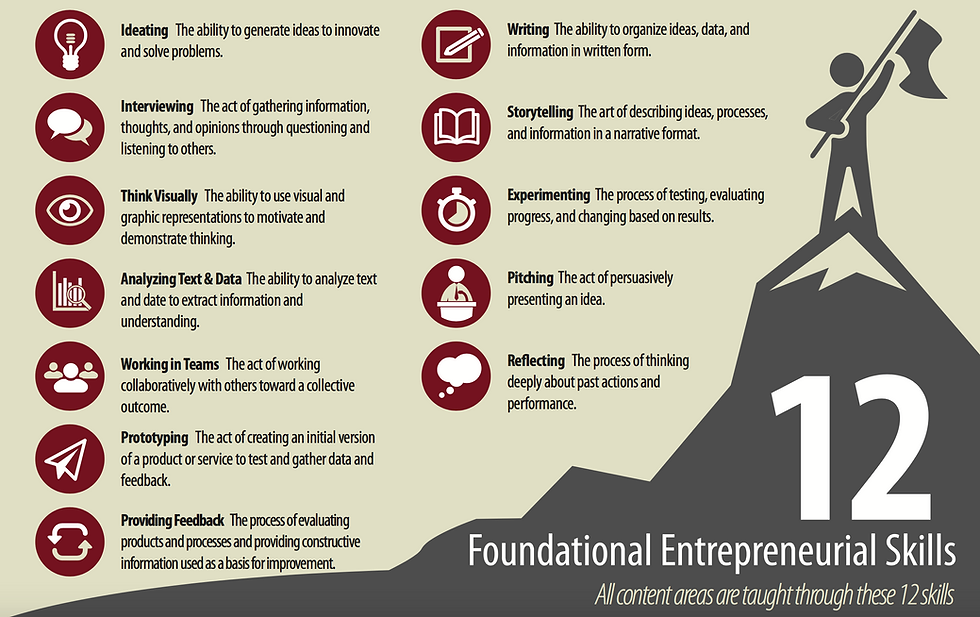Interdisciplinary Skills Umbrella
- Brett Taylor

- Mar 20, 2021
- 5 min read
In the United States, secondary schools and higher education are set up around separate classes based on the subject matter. This was done in order to allow for subject matter experts to teach and dive deep into the content. However, this has created learning in silos. The disjointed nature of this type of learning does not allow students to make the connections they need to in the real world. Different disciplines should connect together, not only helping students make learning connections, but also providing a connected context for teaching and learning.

When I was given the opportunity to start the Patiño School of Entrepreneurship, we were tasked with creating a school completely built around entrepreneurship. We first tried to create a curriculum solely around project-based learning but realized that not all content learning could evolve around entrepreneurship. Eventually, we learned that developing a set of entrepreneurial skills could allow students in all subject matter to learn entrepreneurship and we could connect all of the content in a new and exciting way. Our foundational entrepreneurial skills became the way we taught all subject matter. You can walk into a math class and see pitching, or walk into a social studies class and find students interviewing each other for information. All the while they are using these skills to learn the content subject matter.
Skills Umbrella
Schools that create an umbrella of skills are able to support learning in a connected way. I often refer to this as the skills umbrella. The idea is that the school has selected a context that shares a number of skills under the context umbrella that is shared and taught across the school. The tighter the context, the easier it is to communicate the importance of the skills umbrella to teachers and students. These skills are taught across all subject matter and across all grade levels. The skills umbrella is one of the things that define teaching and learning at schools that adopt them. Schools can have a career-focused umbrella or an umbrella with a broad skills focus, but it has to be meaningful to the students. The umbrella must become the identity of the school.
Content Learning
Sometimes when I introduce the skills umbrella to core content teachers (English, math, science, social studies) they feel I leading them away from their content. Think of the skills umbrella as how to teach, not to what to teach. In this way, the skills umbrella often mirrors the teaching standards but gives teachers and students a more concrete way to understand the teaching strategies. It turns out that most skills will actually support learning the content. When students interview history experts or pitch an alternative governance structure, they are actually learning history. Skills are actually a great way to increase content learning in a way that supports student engagement and critical thinking. Classrooms that are skills-focused on high energy and active. Students can feel the learning.
Teacher Collaboration
One of the difficult things in delivering professional development to secondary teachers is that they are separated by subject matter and they see the educational world through that subject matter lens. When schools are built around shared skills, teachers from different subject matter are able to learn from each other and work together on teaching strategies. A science teacher can actually learn from a math teacher who is having success teaching a specific skill in the classroom. While skills must be tweaked for each subject slightly, using a skills umbrella at a school actually increases the opportunity for teachers to collaborate and learn from each other. The school becomes connected and students start to understand that there is a teaching pedagogy that is connected and transferrable.
Shared Pedagogy
When an adopted set of skills is implemented at a school site, it powerfully advances teaching and learning throughout the site. I remember walking into classrooms during the second year at the Patiño School of Entrepreneurship. It felt like I was walking into classrooms in the second or third month of school. That is because teachers were able to hit the ground running teaching content. They did not need to teach students how to learn. They used the same learning skill sets that students already knew. In high schools throughout the United States, teachers spend so much time putting learning structures in place each year, that learning content is delayed. If a school has a shared pedagogy of skills, students don’t need to relearn a learning structure in classroom to classroom or year to year. Teachers may develop these skill sets, but students already know how to use them. This shared pedagogy of skills accelerates the learning throughout a school.
Skills Transfer
When students are consistently working on skills in their learning every single day, they start to get really good at them. There is a transfer beyond the classroom. This means that students are developing soft skills beyond content knowledge that can help them be successful in careers and life after graduation. I have seen students develop strong speaking, networking, and collaborative skills in schools that use skills umbrellas that they never would have developed in a traditional learning environment. Sometimes, this transition can be jarring. A student who practices these skills over the course of four years in high school is often an expert by the end. At Patiño, we saw students enter with few social or creative skills, that graduated with created businesses, jobs lined up, and scholarships in hand. While their content knowledge helped them in many of these aspects, it is the skills they developed which really separated them. Even college students acknowledged that they were better prepared for time management, critical thinking, and leadership than their peers who had attended traditional high schools.
Models in Action
I have worked with a few schools that have developed different umbrellas of skills. While these are specific examples of contexts, schools can adopt skills under many different umbrellas and contexts. The Patiño School of Entrepreneurship adopted an umbrella of entrepreneurial skills.

Leroy Greene Academy in Sacramento, California is a school with two pathways, Art and Business. They wanted to create a skills umbrella that united the two pathways and connected all of the content areas together. They created an Innovator Toolbox that included skill sets from both the arts and business pathways, as well as shared skills they thought would be important for all students.

Developing a skills umbrella is a great collaborative process for faculty. Be sure to develop parameters and unite the team under an umbrella. A school that shares a skills umbrella creates powerful learning opportunities for students that will impact their lives well beyond graduation.




ความคิดเห็น